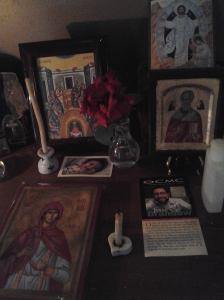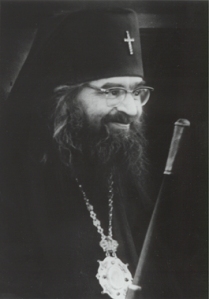
Note: 2015 marks the 100th anniversary of St. Raphael of Brooklyn’s repose in the Lord. Parish Life Conference attendees in the Antiochian Archdiocese will notice that the creative arts festival theme this year is based on the life of St. Raphael. As a result, many of the children in that archdiocese have already studied his life so that they could complete their projects. Here is a brief synopsis of his life, courtesy of the Antiochian Village Camp’s website, for anyone not yet familiar with this saint.
Our holy Father Raphael was born in Syria in 1860 with the name Rafia. The exact date of Raphael’s birth is not known, but he estimated it to be on or near his Name Day, the Synaxis of the Holy Archangels Michael and Gabriel and all the Bodiless Powers of Heaven, November 8.
St. Raphael attended elementary school, where he did very well, but in 1874 it appeared that his father would no longer be able to afford his son’s tuition. Fortunately, help came from Deacon Athanasios Atallah (later Metropolitan of Homs), who recommended to Patriarch Hierotheos of Antioch that Rafia be accepted as a student of the Patriarchate in preparation for the priesthood.
Since the Balamand Seminary had been closed in 1840, Patriarch Joachim III of Constantinople invited the Patiarch of Antioch to send at least one deserving student to study on scholarship at the School of Theology at Halki, and Saint Raphael was the one who was selected to go.
On December 8, 1885 he was ordained to the diaconate at the school chapel. Patriarch Gerasimos of Antioch was impressed with Deacon Raphael and often took him along on his pastoral visitations of his parishes. When His Beatitude could not be present, Deacon Raphael was asked to preach the Word of God to the people.
The Patriarch gave his blessing, and Deacon Raphael was accepted as a student at the Theological Academy in Kiev.
When Patriarch Gerasimos resigned in order to accept the See of Jerusalem, Archmandrite Raphael regarded this as an opportunity to free the Church of Antioch from its domination by foreign hierarchs. In November 1891 Metropolitan Spyridon, a Greek Cypriot, was elected as Patriarch of Antioch. Many Arabs believed that he had purchased the election by distributing 10,000 liras to several notable people in Damascus. Archmandrite Raphael refused to commemorate the new Patriarch during services at the Representation Church. As a result, he was suspended from his priestly functions by Patriarch Spyridon. Saint Raphael accepted his suspension, but continued to write articles in Russian newspapers in defense of the Antiochian cause. The Patriarchs of Antioch, Constantinople, Alexandria and Jerusalem successfully petitioned the Tsar to forbid Russian newspapers from publishing his articles. With this door closed to him, Saint Raphael began to publish his writings in book form. Eventually, Patriarch Spyridon wrote to the Assistant Oberprocurator of Russia, a friend of Saint Raphael’s, asking him to persuade Father Raphael to ask for the Patriarch’s forgiveness. He did so, and the suspension was lifted. Saint Raphael was allowed to transfer from the jurisdiction of Antioch to the Church of Russia, and to remain there. He went to Kazan, taking a position as instructor in Arabic studies at the theological academy. He remained there until 1895 when he was invited by the Syrian Orthodox Benevolent Society of New York to come to that city to be the pastor of the Arab Orthodox community.
Archmandrite Raphael arrived in New York on November 2, 1895 and was welcomed by a delegation of Arab Christians who were awaiting their leader from Russia. On November 5, his first Sunday in America, he assisted Bishop Nicholas in serving the Divine Liturgy at the Russian Church in New York City. Less than two weeks after his arrival, Archmandrite Raphael found a suitable place in lower Manhattan to set up a chapel, and furnished it with ecclesiastical items that he had brought with him from Russia. Bishop Nicholas blessed the new chapel, which was dedicated to St. Nicholas of Myra.
In the summer of 1896, Saint Raphael undertook the first of several pastoral journeys across the continent. He visited thirty cities between New York and San Francisco, seeking out the Master’s lost sheep in cities, towns, and on isolated farms. He fed the spiritually hungry people with the word of God in each place where he stopped. He performed marriages and baptisms, heard confessions, and celebrated the Divine Liturgy in the homes of the faithful where there was no church building. In other words, he zealously fulfilled his ministry as a preacher of the Gospel, enduring many hardships and afflictions, and he was watchful in all things concerning the care of his flock (2 Timothy 4:5).
In 1898, with the blessing of Bishop Nicholas, Saint Raphael produced his first book in the New World – an Arabic language service book titled The Book of True Consolation in the Divine Prayers. This book of liturgical services and prayers was very useful to priests in celebrating the divine services, and also to the people in their personal prayer life. The English version published by Archimandrite Seraphim Nassar is still being used today.
In March 1899, Saint Raphael received permission from Bishop Tikhon to start collecting funds for a cemetery, and for building a new church to replace the chapel, which was located in an old building on a dirty street. In the spring he left on another pastoral tour of 43 cities and towns. In Johnstown, PA, he reconciled those whose personal enmity threatened to divide the Arabic community. Although civil courts had been unable to make peace, Saint Raphael restored calm and put an end to the bitter feud. While in Johnstown, he received a telegram informing him that Metropolitan Melotios (Doumani) had been elected Patriarch of Antioch. With great joy, Saint Raphael told his people that for the first time in 168 years, a native Arab had been chosen as Primate of the Antiochian Church.
After the new Patriarch had been installed, Archimandrite Raphael was proposed to succeed Meletios as Metropolitan of Latakia. The Patriarch, however, stated that the Holy Synod could not elect Father Raphael because of his important work in America. In 1901, Metropolitan Gabriel of Beirut wrote to Archimandrite Raphael asking him to be his auxiliary bishop, but he declined saying he could not leave his American flock. First, he wanted to build a permanent church and to acquire a parish cemetery. The latter goal was achieved in August 1901, when Fr. Raphael purchased a section of Mt. Olivet cemetery on Long Island.
In December 1901, Archimandrite Raphael was elected as Bishop of Zahleh. Patriarch Meletios sent a telegram congratulating him and asking him to return. Father Raphael thanked the Patriarch, but again declined the higher office. He said that he wished to complete the project of building a temple for the Syrian community of New York. The following year, he bought an existing church building on Pacific Street in Brooklyn, and had it remodeled for Orthodox worship. Bishop Tikhon consecrated the church to the great joy of the faithful in attendance. Thus, Saint Raphael’s second major project was finished.
Since the number of parishes with the Diocese of North America was growing, Bishop Tikhon found it impossible to visit all of them. The Diocese had to be reorganized in order to administer it more efficiently. Therefore, Bishop Tikhon submitted a plan to the Russian Holy Synod which would transfer the See from San Francisco to New York because most parishes and individuals were concentrated in the East. Since various ethnic groups required special attention and pastoral leadership, Bishop Tikhon proposed that Archimandrite Raphael be made his second vicar bishop, with the Bishop of Alaska his first.
In 1903, the Holy Synod of Russia unanimously elected Archimandrite Raphael to be the Bishop of Brooklyn, while retaining him as head of the Syro-Arab Orthodox Mission in North America. The Holy Synod announced the election to Patriarch Meletios, who was pleased by their decision. Bishop Tikhon wrote to Saint Raphael to inform him of his election, and Father Raphael sent him a letter of acceptance. Meanwhile, Father Innocent Pustynsky was consecrated at Saint Tikhon’s first auxiliary bishop at St. Petersburg’s Cathedral of Our Lady of Kazan.
On the third Sunday of Great Lent 1904, Saint Raphael became the first Orthodox to be consecrated on American soil. Bishops Tikhon and Innocent performed the consecration at Saint Nicholas Cathedral in Brooklyn. The new bishop’s vestments were a gift from Tsar Nicholas II. After his consecration, Bishop Raphael continued his pastoral labors, ordained priests, and assigned them to parishes, and helped Bishop Tikhon in the administration of the diocese.
At the end of 1904, Bishop Raphael announced his intention to publish a magazine called Al-Kalimat (The Word) as the official publication of the Syro-Arab Mission. Bishop Raphael knew that he could not visit all Orthodox Christians across North America in person, but through the ministry of the printed word he could preach the word of salvation even to people he would never meet.
In July 1905, Bishop Raphael consecrated the grounds for Saint Tikhon’s Monastery and blessed the orphanage at South Canaan, PA. Three days later, he presided at a conference of diocesan clergy at Old Forge, PA, because Archbishop Tikhon was in San Francisco. Among the clergy in attendance were three who would be numbered among the saints: Fathers Alexis Toth, Alexander Hotovitzky, and John Kochurov. (The last two would die as martyrs in Russia.)
For the next ten years, Bishop Raphael tended his growing flock. With the growth of his New York community came an increase in the number of children, and he was concerned about their future. He wanted to establish an evening school to educate them in a Christian atmosphere because the future of the Church in this country depended on the instruction of the youth. Children who did not speak Arabic were already going to non-Orthodox churches, where Sunday School classes were conducted in English. Bishop Raphael saw the absolute necessity for using English in worship and in education for the future progress of the Syro-Arab Mission.
Taking heed of Saint Paul’s words to pray in language that people understood (1 Corinthians 14:15-19), Saint Raphael recommended the use of the Service Book of the Holy Orthodox Catholic Apostolic Church, translated by Isabel Hapgood, in all of his parishes.
In March 1907, Saint Tikhon returned to Russia and was replaced by Archbishop Platon. Once again, Saint Raphael was considered for Episcopal office in Syria, having been nominated to succeed Patriarch Gregory as Metropolitan of Tripoli in 1908. The Holy Synod of Antioch removed Bishop Raphael’s name from the list of candidates, citing various canons forbidding a bishop being transferred from one city to another.
On the Sunday of Orthodoxy in 1911, Bishop Raphael was honored for his fifteen years of pastoral ministry in America. Archbishop Platon presented him with a silver covered icon of Christ and praised him for his work. In his humility, Bishop Raphael could not understand why he should be honored merely for doing his duty (Luke 17:10). He considered himself an “unworthy servant,” yet he did perfectly the work that fell to him (Saint Ignatius of Antioch, Letter to the Ephesians).
Toward the end of 1912, Bishop Raphael became ill while working in his office. Doctors diagnosed him with a heart ailment that eventually caused his death. After two weeks he felt strong enough to celebrate the Liturgy in his cathedral. In 1913-1914, this missionary bishop continued to make pastoral visitations to various cities. In 1915, he fell ill again and spent two months at home, bearing his illness with patience. At 12:40 am on February 27, he rested from his labors.
From his youth, Saint Raphael’s greatest joy was to serve the Church. When he came to America, he found his people scattered abroad, and he called them to unity. He never neglected his flock, but traveled throughout America, Canada, and Mexico in search of them so that he might care for them. He kept them from straying into strange pastures, and he protected them from spiritual harm. During twenty years of faithful ministry, he nurtured them and helped them to grow. At the time of his death, the Syro-Arab Mission had thirty parishes with 25,000 faithful.
Saint Raphael came into contact with all sorts of people, and was a gentle father to them. He gained their love and respect by first loving them, and also through his charming personality and excellent character. He was always kind and merciful with others, but was strict with himself. He accomplished many good things during his earthly life, and now he joins the holy angels in offering ceaseless prayer and praise to God.
Above excerpts taken from The Orthodox Church April/May 2000
(Reprinted with permission from https://avcamp.org/st-raphael-of-brooklyn/)
Rejoice, O Father Raphael, Adornment of the holy Church! Thou art Champion of the True Faith, Seeker of the lost, Consolation of the oppressed, Father to orphans, and Friend of the poor, Peacemaker and Good Shepherd, Joy of all the Orthodox, Son of Antioch, Boast of America; Intercede with Christ God for us and for all who honor thee.
Read a more in-depth telling of St. Raphael’s life here: http://oca.org/saints/lives/2015/02/27/100610-repose-of-st-raphael-the-bishop-of-brooklyn
In case you wondered why St. Raphael has two different commemoration days listed, read this: http://www.angelfire.com/pa3/straphaelcanonized/lives/DateFeast.html
Here are additional ways to help your students learn about St. Raphael:
***
Find ideas for teaching children about the life of St. Raphael throughout the Sunday Church School year, here: http://www.antiochian.org/festivals/cf/using-the-theme-2015
***
Find printable posters about St. Raphael and a few of the churches he founded, here: http://www.antiochian.org/festivals/cf/posters-2015
***
Find pictures from the life of St. Raphael here: http://www.antiochian.org/category/image-galleries/antiochian-stock-imagery/icons/saints/st-raphael-brooklyn
***
Select your students’ grade level and teach them about St. Raphael from the lesson plans and printables found here: http://dce.oca.org/assets/files/mini-units/saints-of-south-canaan.pdf
***
Older students can read about St. Raphael’s life, and then look for the details in the service held in his honor on the first Saturday of November. Find the text for the service here: http://www.dowama.org/sites/docs/SVCRaphaelAkolouthia.pdf
***
After studying the life of St. Raphael of Brooklyn, students can go online and take this trivia quiz to see how much they know about his life! http://www.funtrivia.com/html5/index.cfm?qid=265273






